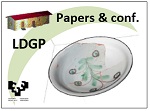Study, revalorization and virtual musealization of a ceramic kiln based on information gathered from old excavations
Date
2017-08Author
Rodriguez-Miranda, Alvaro
Metadata
Show full item record
Rodríguez Miranda, Á., Valle Melón, J.M., Calparsoro, E., & Iñañez, J.G. 2017. Study, revalorization and virtual musealization of a ceramic kiln based on information gathered from old excavations. Digital Applications in Archaeology and Cultural Heritage, 7, 1-9, doi: http://dx.doi.org/10.1016/j.daach.2017.08.003
Abstract
[ES] Las posibilidades actuales de visualización y difusión a través de las tecnologías digitales tienen un efecto favorable en la conservación y la puesta en valor de los restos arqueológicos depositados en los museos. Por lo tanto, deben ser consideradas como herramientas esenciales en la gestión de las colecciones y una manera de comunicarse con todo tipo de usuarios, desde los que cuentan con un elevado perfil tecnológico hasta los visitantes ocasionales.
El artículo presenta un caso de estudio en el cual se ha revisado la información recogida durante una serie de excavaciones arqueológicas relativas a los restos de un horno, las cuales se realizaron en la localidad de Orduña (España) en los años 2000 y 2001. Esta información, conjuntamente con una nueva inspección de las piezas almacenadas en el Museo Arqueológico de Bizkaia, ha permitido la generación de nuevos productos -como el modelo virtual tridimensional- que ofrecen posibilidades mejoradas de estudio, comprensión y difusión de las piezas, su origen y la importancia que el oficio de la cerámica y su comercio tuvieron en el pasado. [EN] The current possibilities of virtualization and dissemination by means of digital technologies have a favourable effect on the conservation and valorization of archaeological findings held in museums. Therefore, they should be considered as essential tools in the management of the collections and a way to communicate with all kind of users, from the ones with a highly technical profile to the occasional visitors.
This article presents a case in point, in which the reviewing of the information generated during a series of archaeological excavations into the remains of a kiln, conducted in the town of Orduña (Spain) in 2000 and 2001, together with a new inspection of the pieces stored in the Bizkaia Museum of Archaeology, allowed for the generation of new products such as three-dimensional virtual models that improve the possibilities of studying, understanding and disseminating the pieces, their provenance and the importance that the craft and the trade of the pottery had in the past.
 Back
Back
